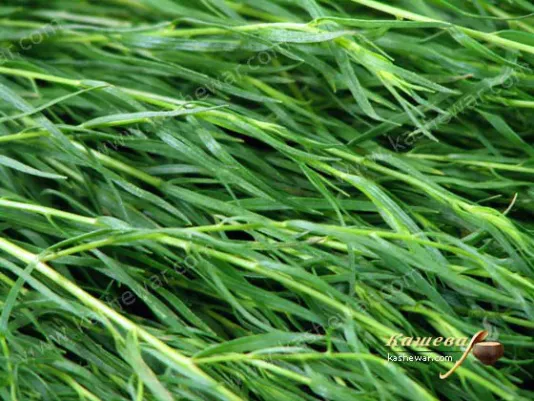Shrimp and Cucumber Salad with Horseradish Mayonnaise
Shrimp and Cucumber Salad with Horseradish Mayonnaise – Swedish recipe, an interesting salad served on a slice of rye bread.

Tarragon has a special reputation among chefs, and I understand why. Over the years, I’ve learned that this herb is not for the background, but for the accent. Its aroma activates when it meets heat, so I add tarragon at the end of cooking or to a warm sauce rather than to a boiling dish. Fresh and dried leaves have different intensities, so I always test the strength before using them. Fresh tarragon gives a bright green hue and a light anise flavor, while dried tarragon is earthier and warmer. I especially love the French approach: combining tarragon with vinegar or oil to create the base for marinades and sauces. In salads, it adds freshness; in chicken – refinement; in fish – purity of flavor. And every time I open a jar of its leaves, I feel the same certainty – the dish will be harmonious.
Over the years of cooking, I’ve learned to recognize quality tarragon in just seconds. Fresh leaves should be firm, bright green, without dark spots or wilting. The aroma is the key indicator: real tarragon immediately releases a light yet recognizable anise scent with no foreign notes. If the herb has no smell, it has lost its essential oils, and the taste will be flat. When buying dried tarragon, pay attention to the color: it should remain green, not gray-brown. Leaves that are too finely chopped lose their aroma quickly, so I always choose medium-cut ones. When storing fresh herbs, I wrap them in a slightly damp towel and place them in a container in the refrigerator – this keeps them fresh for several days. I store dried tarragon in a tightly sealed jar, away from light and heat. Moisture is the main enemy of this herb, so I never leave it open on the kitchen counter, even briefly. Tarragon harvested in mid-summer is the most aromatic – that’s when its essential oils reach their peak.
Before adding tarragon, I always check its condition: if the leaves are fresh, I simply strip them from the stems and finely chop them. Dried tarragon needs a bit of awakening – I gently rub it between my fingers or add a few drops of warm water to revive the aroma. In marinades, the herb releases its flavor more slowly, so I add it several hours before use, while in sauces – right before serving. When cooking with butter, I keep it over low heat so the essential oils don’t burn – excessive temperature destroys the delicate aroma. For sauces like beurre blanc or hollandaise, I add tarragon at the very end, once the sauce is off the heat. In cold dishes, especially those with eggs or cheese, fresh leaves are best cut with a thin-bladed knife to avoid squeezing out the juices. In my experience, even a small amount of this herb can change the balance of flavor, so I always recommend adding it gradually, tasting several times until harmony is found.
Temperature plays a major role when it comes to tarragon. Its essential oils are highly volatile, so they simply disappear with prolonged heating. In my practice, I never put tarragon into a boiling dish: it’s enough to add it during gentle simmering or right after removing from heat. In sauces and oils, the temperature should not exceed 70°C (160°F) to preserve the aroma. For marinades, I use warm, not hot liquid: too hot will damage the leaf structure. When roasting, I place a few sprigs inside the meat before baking so the aroma infuses gradually. In soups and broths, I add tarragon at the very end, just a minute before they’re ready. This way it releases its fragrance without losing brightness. Even during reheating, dishes with tarragon should not boil – it’s better to warm them slowly, covered. This approach helps preserve the herb’s natural freshness, which gives the dish its liveliness.
Tarragon pairs beautifully with acidic and fatty components – this is one of the main rules I’ve learned. Its anise-like freshness softens the richness of fatty meats, creamy sauces, or mayonnaise, adding lightness. In marinades, it harmonizes with vinegar and lemon juice, creating balanced acidity. In poultry dishes, especially chicken or turkey, tarragon enhances the tenderness of the meat. With eggs, it works flawlessly: omelets, sauces, poached eggs – everywhere it adds elegance. In fish, it brings brightness, and in vegetable dishes, it structures the flavor when you want something herbal but not sharp. I rarely mix tarragon with strong spices like garlic or cumin, as they overpower its character. But with dill, parsley, basil, or onion, it forms harmonious combinations. In desserts, especially citrus ones, a small pinch of dried tarragon gives an unexpectedly intriguing aroma. The key is moderation, as too much quickly turns the taste soapy.
The most common mistake I’ve seen in kitchens is overusing tarragon. Its aroma quickly turns bitter, especially when overheated. That’s why I always add it at the end, even when the flavor seems too mild. The second mistake is using old dried herbs: after six months, they lose potency, and the dish becomes bland. Supplies should be refreshed at least twice a year. Another frequent issue is mixing it with incompatible spices. Tarragon doesn’t tolerate excess salt or heat, as it loses its complexity. I check quality by scent: if the herb doesn’t change the aroma of the dish after being added, it’s either old or poorly stored. When making cream-based sauces, extra care is crucial – overheating ruins both flavor and texture. To preserve aroma, I recommend covering the finished dish with a lid for a few minutes: it gives the herb time to open up. Everything related to tarragon requires moderation and attentiveness – that’s its true secret.